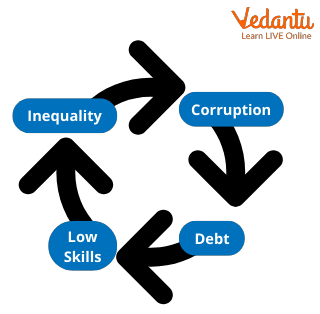




Debt Free Countries: Top Nations without National Debt
Many countries around the world are struggling with their increased obligations in the form of debt but have maintained it quite low. A low level of debt shows less reliance on foreign borrowings. The best example can be taken from Hong Kong (it is a one of the debt free countries), whose economy has the least debt to GDP ratio. It is an almost debt free country. It has a well-regulated financial system and large foreign reserves. Its per capita GDP is the highest in the world, around £32,000. Countries with the most debt are Japan, Venezuela, Italy etc. Want to know which countries are debt-free? Here is a list of debt free countries.

Debt
What is Public Debt?
Public debt is defined as the total amount of liabilities which is followed by the government to meet the development budgets of the country. Public debt is generally expressed as the ratio of Gross Domestic Product (GDP). The debt can be raised both in the form of external or internal means. Internal debt includes the debt borrowed within the country, and external debt is the debt that is put to lenders outside the country. Public debt is considered an important source for the government to meet its obligation and fulfil the needs of the economy.

Debt Needs to be Secured
Countries That Have the Biggest Amount of National Debt
According to the IMF (International Monetary Fund), the total amount of debt that is held by the government throughout the world has reached around $164 trillion in 2016. The debt by a country is measured in terms of the debt-to-GDP ratio. The highest debt countries have more obligations than those debt free countries. The countries with the highest debt countries are Venezuela, Japan, Greece, Italy, the USA, France, and the UK.
Debt to GDP Ratio
Debt-to-GDP ratio is measured as a country’s public debt to its GDP (Gross Domestic Product). This ratio indicates the country’s ability to repay its debts. When the debt to GDP ratio is low, it indicates that any economy produces more goods and services and is sufficient to pay back its debt. Higher debt-to-GDP ratio means they would be the highest debt countries and less debt-to-GDP ratio means they will be debt-free countries.
Top 10 Debt Free Countries 2025
The Highest Debt Countries are as Follows:
Below is the debt list of countries. The highest debt countries are Venezuela, Japan, Sudan, Greece, etc.
High Debt to GDP Ratio is a Danger Sign
Increasing public debt is a sign of worry. The research by the World Bank has shown that countries with debt-to-GDP ratios higher than 77% have faced economic slowdown over time. Debt-to-GDP ratio is an indicator of a country defaulting on its debt which may further lead to a financial crisis. The issue of debt has been increasing since the time of COVID-19. In this, the country with no debt is decreasing. With the increasing interest rate, government expenditure will slow down and will cause worry about the sustainability of the debt of the nation. The heavily indebted countries will feel the effect of these financial conditions, which will harm the growth prospects over time. Countries with no debt do not have such danger signs.

Problem with the Less Developed Countries
Countries with the Lowest National Debt
A low debt-to-GDP ratio is considered to be desired, but it does not indicate a healthy economy. These are called debt-free countries. Many developing and stagnant economies have a low debt-to-GDP ratio because both their debt and their GDP are quite low. If a country borrows from another country and invests for economic growth, then, in the long run, the economy could be a healthy economy because of continued learning and increased profit in future. As economic growth is not guaranteed, such a type of following could also be a bank fire, as in the case of Venezuela.
Countries with no debt or the least amount of debt are as follows:
Conclusion
With the increasing amount of debt around the globe, cost increases the risk of default and slow economic growth for the countries. Though with the help of debt, some countries are trying to overcome the slowdown caused by the pandemic lockdowns. Higher debt comes with slow growth potential and increases deficit spending with unpredictable long-term consequences. Countries with no debt have less risk, but they may further suffer in case of development.
FAQs on List of Debt Free Countries
1. What can be a sustainable debt-to-GDP ratio?
The ability of the country to pay its debt is reflected in its debt-to-GDP ratio. The lower the ratio, the healthier the economy will be. A country can only achieve sustainable external debt if its current external debt obligations and future obligations are met without the accumulation of more debt or compromising growth. Sustainability can be achieved by bringing down the net present value (NPV) of the external debt to around 150% of the export of the country or 250% of the revenue of the country.
2. What is the status of India regarding that Debt to GDP ratio?
Since 1991, the debt-to-GDP ratio of India has remained stable at 70%. The increase in the amount of public spending is due to a loss in revenue, which is costly due to the pandemic. This will stabilise around 2024. In order to support the backward section, the government is taking fiscal action which will strengthen market confidence and enhance India’s growth. Financial stability is very important for a healthy debt-to-GDP ratio. As per the Fiscal Regulation and Budget Management (FRBM) Act, the debt-to-GDP ratio should be around 60%. A higher debt-to-GDP ratio will lead to more money going towards interest payments and also will lead to a crowding out effect.
3. What are the objectives of public debt and borrowing?
It is very important for the government to borrow funds. It is because of the gap between expenditure and borrowing. Various reasons for borrowing or to curb inflation, overcome the depression in the economy, formulate a financial development plan, expand education and health services, and achieve economic stability. It also ensures that the financing needs of the government are met at the lowest cost and with less amount of risk. The government borrows money for financial development activity.
4. What are debt free countries?
Debt free countries are nations that have minimal or no national debt. They manage their finances responsibly, ensuring government spending does not exceed their revenue.
5. Which are the debt free countries in the world?
The debt free countries in the world include nations like Hong Kong, Brunei, and Timor-Leste, known for their low national debt levels and sound economic policies.
6. Are any countries completely debt free?
While no country is entirely debt free, some nations have extremely low debt-to-GDP ratios. Examples include Brunei, Timor-Leste, and Hong Kong.
7. What are the debt free countries in 2025?
As of 2025, top debt free countries include:
Hong Kong
Brunei
Timor-Leste
Afghanistan
Turkmenistan
8. What countries are considered debt free?
Countries like Brunei, Hong Kong, and Kuwait are considered debt free or maintain very low levels of debt. They achieve this through effective fiscal management.
9. How many countries in the world are debt free?
There are very few countries that are completely debt free. However, several nations have low debt-to-GDP ratios, making them almost debt free.
10. Can you provide a list of debt free countries?
Here is a list of some of the debt free or low-debt countries:
Hong Kong
Brunei
Timor-Leste
Turkmenistan
Kuwait
Solomon Islands
11. What are the top 10 debt free countries in 2025?
The top 10 debt free countries in 2025 are:
Hong Kong
Brunei
Timor-Leste
Afghanistan
Turkmenistan
Tuvalu
Kuwait
Solomon Islands
DR Congo
Russia





















